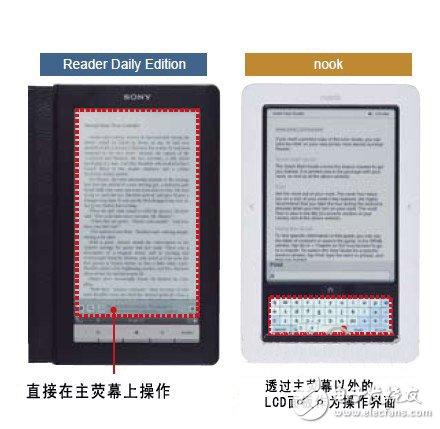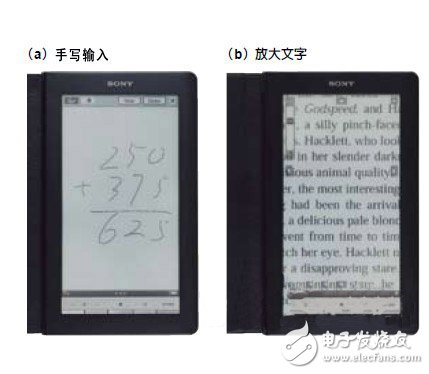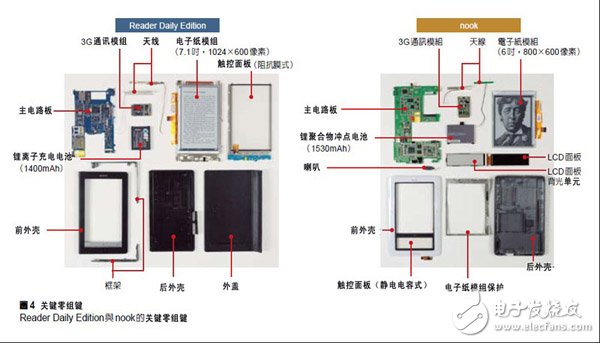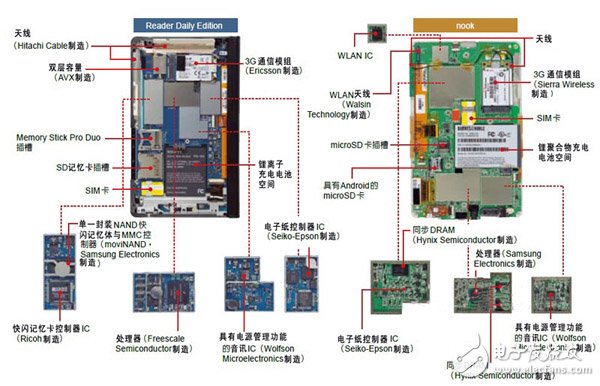The keyboard is "unwanted". Tips for using the touch panel
"There was all the excesses removed," said Noguchi of Sony Electronics. Sony's Reader Daily Edition eliminates the Kindle's keyboard as a superfluous object, enabling readers to easily access the operability of reading directly. The full screen can be operated directly on the touch panel (Figure 2).

Figure 2 The main difference in operation
Reader Daily Edition has a touch panel on e-paper that can be operated directly on the screen. Nook offers a separate LCD display in addition to electronic paper with a touch panel.
As you can see from the actual operation, you can use the full-screen touch panel to achieve a variety of functions. For example, you can write text or pictures on the screen freely, or operate on the screen to enlarge the text on the screen (Figure 3).

Figure 3 Writing and zooming on the screen
Reader Daily Edition has the function (a) for the user to write and draw on the screen, and to enlarge the selected text (b).
Sony Electronics' Noguchi is proud to say that it will surprise people who are familiar with the performance of electronic paper. The update rate of electronic paper is quite slow, so that the screen can keep up with the speed of handwriting input. It's impossible, however, on Sony's reader, there is no delay. To do this, not only the special type of electronic paper, but also software assistance. “Since LIBRIÉ, we have learned about E Ink's e-paper features for some time, so we can develop the best algorithms,†Noguchi said. This is a good example of a deep understanding of the hardware's ability to achieve distinctive operability.
Barnes & Noble's nook also doesn't have a keyboard, but its operating system is completely different. Instead of the main screen, the operation is equipped with a separate LCD touch display panel (Fig. 2), for example, text can be entered on the software keyboard displayed on it. Although this dual-screen design has other advantages, industry experts point out that the potential of this design has not yet been fully realized.
Basic design and the same details of the Kindle 2 lead to differencesWhat improvements have been made to the hardware to provide an excellent reading experience? This time, with the help of several e-book terminal companies and engineers from communication-related companies, we disassembled Reader Daily Edition and Nook. Reader Daily Edition was designed and manufactured by Sony, and Nook was developed by electronics manufacturing service provider (EMS) for bookstore Barnes & Noble. Their origins are quite different.
There are roughly two characteristics in the disassembly. First, the two products are very similar in basic hardware design. Second, the Reader Daily Edition has special considerations for operational enhancements, style, and toughness in the details of hardware design.
The circuit architecture of the two is almost the same
"What will happen?..." In the usual disassembly, the most exciting thing is the moment to open the case. But this time the engineer did not change his expression from the time he opened the case to the beginning of the disassembly. It seems that there is nothing particularly worth mentioning inside the two e-books. Even comparing parts and checking the main circuit board, we still don't see big differences (Figures 4 and 5).

Figure 4 key components
Reader Daily Edition and key components of nook.

Figure 5 main board comparison
Reader Daily Edition and Nook remove their back shells. The protected shield is also removed. The description of the part is speculation.
An engineer commented that the circuit architecture looks quite close to the design concept of the mobile phone, and that the processor, 3G communication module and other parts are neatly arranged. This is very similar to Amazon.com's Kindle 2 design.
However, careful inspection of individual components revealed that there were some subtle differences between the two models, such as (1) different battery positions; (2) different antenna sizes and (3) different ways of fixing electronic paper.
Since AC power cord is output of high voltage electric power, there is a risk of electric shock injury, therefore, All the AC power cord must comply with safety standard to produce. AC (Alternating Current) Power cord is to transmit high voltage. It is used to drive machinery or home appliances.
AC Power cord,power cable, batter cable, power cord
ETOP WIREHARNESS LIMITED , https://www.oemwireharness.com